Abstract
To be successful in a circular economy, it is important to keep the cost of operationalizing remanufacturing processes low in order to retain as much value of the product as possible. Optimizing operations for disassembly, as a key process step, is therefore an important prerequisite for economically viable circular manufacturing. The generation of fit-to-resource disassembly instructions is labor-intensive and challenging because (digital) product information is often lacking at End-of-Life. With upcoming EU regulations for Eco-design for Sustainable Products in mind, including the future use of Digital Product Passports, it is time to think about standardized methods to capture disassembly information for products. First requirements from small and medium-sized remanufacturing companies have been collected and compared with available frameworks for modeling product topology, parameters, and (dis)assembly process rationale. Based on this, the disassembly hypergraph is presented as a concept for recording ‘resource-agnostic disassembly guides’ in (machine-readable) product models to determine required disassembly actions and tools ‘smartly’. The concept builds upon existing models. Additionally, suitable methods for the collection of disassembly information are explored, resulting in preliminary insights from disassembly data collection workshops. Although the approach is promising, future work is needed to expand the concept of the disassembly hypergraph with both guidelines for setting up disassembly ontologies and further systematic disassembly knowledge extraction in order to apply this as a useful means for companies to rationalize their disassembly operations.
1. Introduction
1.1. Need for Disassembly Models
Transitioning from a linear to a circular economy requires innovative solutions to facilitate repair, remanufacturing, refurbishment, recycling, and predictive maintenance (in short, ReX) [1]. The desire of companies to do ‘the right thing’ for people and the climate plays a role in their motivation to pursue circular business, but it is also increasingly enforced by EU climate regulations and directives for lowering their footprint like the Eco-design for Sustainable Products Regulation (ESPR), Corporate Sustainability Reporting Directive (CSRD), and Corporate Sustainability Due Diligence Directive (CSDDD) [2,3]. Small and medium-sized enterprises (SMEs) in the manufacturing industry are increasingly interested in disassembly solutions for products when they are End-of-(Service) Life. Each ReX strategy starts with a certain amount of product disassembly. However, disassembly processes are currently labor-intensive [4], which raises questions about their economic viability. Disassembly labor cost depends primarily on how well a product was designed for disassembly, the complexity of the product, requirements for dedicated tools, and the efficiency of process. Models for estimating disassembly costs are proposed in [5,6,7]. The fraction of disassembly labor cost related to overall remanufacturing cost is estimated at around 22% for the example of a car (given in [8]). So, there is definitely interest in (partly) automating and digitizing these processes to lower labor costs, but this is challenging for processes that currently rely on experienced staff with particular skills. Additionally, ‘coding’ for small series is also expensive. Many existing products have been developed without paying attention to disassembly and reassembly. As Hjorth [9] states, “processes remain inefficient due to the high degree of complexity and variation in the products”. ‘Disassemblability’, or the extent to which a product can be easily disassembled, is an important variable for the scalability of circular manufacturing [10]. It is largely determined by product properties, but for companies, it is also relevant to know the impact of available tooling and know-how. The latter, mainly available through practical experience, is not parameterized or formally captured. Therefore, many disassembly plans are currently made ‘to order’ (if they are made at all). Problems identified and summarized by Poschmann et al. [11] are required process flexibility, high planning costs, low level of technology, and no process optimization; products coming in a high number of variants, with varying conditions and diverse materials; and information about requirements, part history, and components often being lacking. Also, the ‘triage’ of products (series) before circular operations (Should we do this? How are we going to do it?) is important for scaling up ReX [12]. Formal criteria to determine whether disassembly is worthwhile are often lacking. Manufacturing engineering and operations management for disassembly have not received a lot of professional or academic attention yet. With the upcoming ESPR legislation and, with this, the use of Digital Product Passports (DPPs) within reach, it is time to think about user-friendly and standardized ways to document disassembly guidelines for a product. This is achieved either by design or at End-of-(Service)-Life as part of the transaction from user to ReX manufacturer. In particular, third-party manufacturers that do not have access to digital product data can benefit from such standardized methods [13]. Current research into batteries [14,15] proposes a DPP format that contains the following: exploded diagrams and layouts of the system showing the location of the components; disassembly sequence, type, and the number of fasteners; tools required; warnings for parts that are easily damaged. No specifications exist yet on how this information can be standardized and documented in such a way that it can be used for automated disassembly. Most research work on disassembly plans has been carried out with the goal of improving Design-for-Disassembly or Design-for-ReX. The disassembly plan is then, for instance, used to determine disassemblability or estimated disassembly time to rank design alternatives (see, for instance, [16,17,18]). Other research addresses optimal disassembly sequences [19,20,21] but gives less attention to the practical considerations of how to capture baseline information as input for such methods.
The goal of this research, therefore, is to identify a flexible method to capture product topology to identify connections to break and the components and sub-assemblies to handle, as well as to be able to reason the acceptable route(s) to a target component. It should also capture the characteristics of the component required for tool and equipment selection. This is what Zheng [22] calls the ‘product dimension’ of the disassembly system (product attributes, product structure, product specification, disassembly relation, damage conditions, and technical, material, shape and precision characteristics of components). As such, it begins as a resource-agnostic model. When subsequently (and systematically) combined with knowledge about available disassembly resources, this should lower the required effort for coding for automatic disassembly or for the creation of detailed disassembly instructions. Such a method should be scalable with respect to large and complex product structures and should be able to deal with hierarchic product structures (sub-assemblies). The models should be easy to visualize. To ensure that modeling costs do not offset potential cost savings, it is desirable to achieve a certain degree of ‘reuse’ of product models through parameterization, similarity mapping, and other techniques. Furthermore, it is essential that not only low-skilled employees but also laypersons are able to utilize these disassembly models and contribute to a ‘product model repository’ by documenting disassembly processes. This last aspect would unlock possibilities for ‘citizen science’ as a source for systematically building product topology knowledge for disassembly (for instance, in Repair Cafes, classrooms, etc.).
1.2. Existing Concepts for Modeling Product Topology
A first explorative literature review was executed based on the keywords “(dis)assembly maps”, “(dis)assembly plans”, and “(dis)assembly sequence” from research groups that actively gather empirical data for Design-for-Disassembly or research groups with a ‘remanufacturing lab’. Articles focused on finding optimal disassembly sequences were only reviewed for their capturing of components and connectors.
De Fazio [16] introduces his “Disassembly Map” method with an overview of authors that draw on the concept of ‘liaison graphs’ in which components are represented as nodes and their connections as edges, as shown in Figure 1.
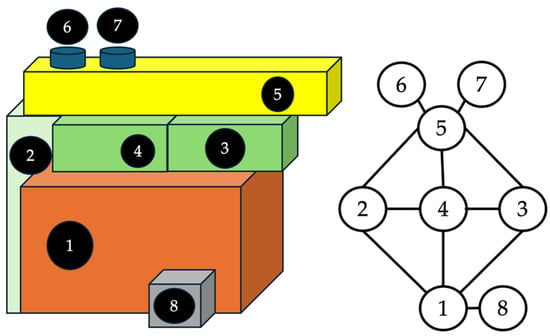
Figure 1.
Liaison graph concept (example taken from [23]).
Alternative naming for similar concepts includes connection graph, liaison graph, part mating graph, adjacency graph, etc. (See articles either cited by De Fazio, the review by Ong [21] or found by snowballing [23,24,25,26,27,28]. This list is not exhaustive). In addition to modeling products as directed graphs, weighted graphs can be used to ‘store’ relevant properties of nodes and edges. Graphs are, therefore, preferred over adjacency matrices as these usually only represent the presence of a connection. If the edge contains a property on ‘effort involved in ‘breaking’ the connection’, graphs can be submitted for topological sorting to find the shortest path to disassemble a product or the shortest route to a particular component. Weighted graphs can more efficiently handle sparse connections than adjacency matrices can; the latter are also more cumbersome to modify when large. Concepts like ‘graph edit distance’ (see, for instance, Riesen [29]) can be applied to evaluate similarity between products represented as graphs. Finally, a graph gives a more intuitive visual representation of a product than a matrix.
The ‘node-property’ concept is close to the ‘handling index’ of Boothroyd [30], which takes into account the size, weight, fragility, stickiness, orientation, symmetry, etc., of components in an assembly and the ‘fitting index’ that covers the direction, access, alignment, fastening type, etc., of connections between components (in the context of disassembly, it would be ‘de-fitting’). As is argued by Erdmann et al. [31], a connection taxonomy can highlight relevant properties and provide a preselection of the tools and expertise required to release the connection. In the standard on ‘repairability’ [32], a distinction is being made between reusable, removable, and non-removable connectors. This is relevant information for handling and sorting in the disassembly plan. Also, available information about the condition of the connection, e.g., whether it is dirty or damaged, etc., is relevant (see, for instance, [33]).
Das and Naik [34] propose a product description by means of a standardized table of components and disassembly-relevant properties of each component (such as weight, material, potential hazards, etc.). The connections also have properties relevant to disassembly, i.e., whether there is a so-called ‘mating’ relationship (which implies that components are attached to each other and limit another parts’ Degrees-of-Freedom). Several types of ‘mating’ exist: type 1 coupling—parts are assembled with separate fasteners; type 2 coupling—parts are assembled with fasteners that are an integral part of one of the parts (e.g., because there is thread in the parts); type 3 coupling—parts are assembled, but there is no direct attachment. For more information, see Table 1.

Table 1.
Connection category typification (according to [34]).
Additionally, accessibility information must be added to the connection, namely the geometric dimensions for a ‘collision-free’ path for both the tool and for part removal. This is provided by the typology of [34], as shown in Figure 2. Although this typology is very pragmatic, it is only relevant (or true) when reasoned from a certain orientation (see, for instance, G01-G05); these cannot be discerned from a G06, when you approach such a connection from below instead of from the top.
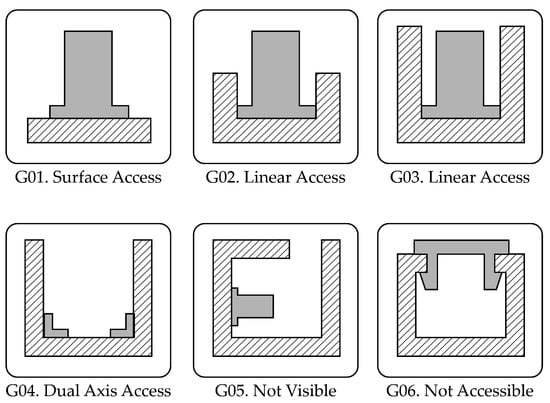
Figure 2.
Accessibility typology (source: [34]).
The literature that evaluates the accessibility of connectors from a CAD geometry model was ignored for now as a source for the typification of accessibility, as such information is usually not available in the use cases defined for this research.
Bozkho [35] presents a workable method to model sub-assemblies by means of so-called hypergraphs. Hypergraphs can represent hierarchy in product structures by modeling sub-assemblies as hyperedges. Multiple nodes can be connected in the hyperedge, and Bozhko does that based on the mutual geometric coordination of the parts. The concept of hyperedge also allows for more comprehensive modeling of sub-assemblies and identification of optimal disassembly sequences by first focusing on connections between sub-assemblies and only then connections within sub-assemblies (if needed). Isawe [20] defines a sub-assembly in the context of disassembly as either “feasible sub-assemblies appearing in disassembly sequences” (ad-hoc) or “designer-defined sub-assemblies enabling multiple parts to be removed at once for ease of disassembly and maintenance”. This ‘ad-hoc’ definition is probably not strictly dependent on the product features itself, as feasibility could also depend on the methods and tools used. The concept of sub-assemblies is relevant for disassembly efficiency, because it allows work to be executed in parallel, as well as individuals to focus disassembly actions on particular components that need to be accessed for repair or replacement, while the remainder of the product remains intact. As Wang et al. [36] explain, although the product topology at the component level determines what are valid or non-valid sequential disassembly sequences, to generate sequences of parallel disassembly, sub-assemblies have to be taken into account. Trigui [37] observes that nodes in a liaison graph with a relatively high number of edges to other parts, often are considered as ‘base parts’. When breaking the edges between such base parts, this often gives a good indication of sub-assemblies. Many authors discuss algorithms for determining optimal disassembly sequences, i.e., Iwase [20], who demonstrates the generation of AND/OR graphs from disassembly hypergraphs as a concept for finding alternative disassembly paths. The article also presents the concept of the ‘cut-set’ matrix to identify the connections between sub-assemblies mathematically. But, the algorithm proposed cannot handle all geometrical constraints, which means that human evaluation of alternative paths is still needed to exclude the infeasible ones.
Hypergraphs offer significant advantages over traditional graphs in disassembly process modeling. While conventional graphs rely on pairwise connections between nodes, hypergraphs utilize hyperedges to group multiple components into meaningful sets. As such, they provide the ability to process grouped components simultaneously, whereas traditional graphs typically necessitate sequential operations [20,35]. This provides operational benefits, especially for products with a high number of components. For disassembly hypergraphs, two types of hyperedges could be applied; first, hyperedges that unite components accessible at a certain geometrical orientation (as Bozhko proposes); secondly, components at similar disassembly depth levels. Nodes and edges are members of both types of hyperedges. The accessibility of nodes (components) for manipulation and edges (connectors) for disconnection is then defined in relation to the hypergraph membership (as a fastener is only accessible for a certain product orientation, or a component is only accessible once other parts or sub-assemblies have been removed.) This is in contrast with the flat structures of normal graphs. It should be noted that sub-assemblies are usually ‘by design’ optimized for assembly and not for the shortest disassembly route to a target component, unless the principles of Design-for-Disassembly have been applied.
A feasible sequence of disassembly operations on hyperedges is called the ‘hyperpath’ [38]. The evaluation of hyperpaths is less demanding than generating all possible disassembly sequences for a ‘normal’ graph, as long as the number of hyperedges is lower than the number of nodes. In numerous disassembly scenarios, it is not necessary to disassemble all sub-assemblies (hyperedges). Additionally, by partitioning the graph-based on the orientation of nodes and edges, many infeasible disassembly paths are excluded upfront. This approach facilitates the effective management of complex structures, thereby making the disassembly of a hypergraph a highly scalable concept [38].
1.3. Existing Concepts (Dis)Assembly Process Modeling
Having covered the product model, the next requirement is to use topology, resource typification, and possibly other knowledge rules to move towards a disassembly plan. The aforementioned Disassembly Map created by De Fazio [16] was developed primarily as a design tool: based on the disassembly description (aimed at manual disassembly), designers are asked to analyze each disassembly step and improve disassemblability, e.g., by clustering components to gain easy access to parts that need to be repaired or maintained frequently. De Fazio assesses product features as the disassembly sequence/depth, required force, and type of tool for and reusability/reversibility of fasteners. A process feature like disassembly time is based on the Ease of Disassembly Metric (eDIM) and the Maynard Operation Sequence Technique (MOST) [17] under the assumption that the disassembly is executed manually with the preferred hand tool. To the best of the authors’ knowledge, no such metrics are available yet for automatic disassembly, which is an omission: The existing eDIM and MOST methodologies require revision and expansion to accommodate automated and semi-automated disassembly processes beyond their current focus on manual operations. Such an expansion should, for instance, be able to handle the aspect of pose.
In order to generate Product Disassembly Plans that take capabilities into account, not only fastener or connection taxonomy [31] but also tool taxonomy is required. In the standard for the assessment of repairability [32], a first classification for tools is given (also indicating product group-specific or propriety tools). Product features such as the material and weight of components can then be used to reason towards the selection of the most suitable, available tool or to specify a disassembly handling-like force required to break a connection. “Standard disassembly steps”, as presented by Vanegas [18], can be used as a starting point for the systematic description and enumeration of disassembly actions, including product manipulation, connector identification, tool change, tool positioning, and the disconnection and removal of parts. In the metamodel for disassembly developed by Zheng [22], this is indicated as the disassembly tasks that depend on disassembly equipment and part operations instructions.
1.4. Remaining Questions Concerning Disassembly Graphs
Building upon the work presented in the previous sections, extending the disassembly hypergraph concept with orientation and depth hyperedges seems a promising and efficient approach to record a ‘disassembly blueprint’ including sub-assemblies and geometric constraints. Nevertheless, no practical applications are known for this type of disassembly hypergraph; neither are there any methods documented to efficiently collect data for a disassembly hypergraph repository.
Therefore, this work addresses the following questions: Can the disassembly hypergraph be satisfactorily applied to capture product information for disassembly (that is independent of organization capabilities)? Can the hypergraph be used to create instructions for (automated) disassembly? How can we design a data collection process to build up a disassembly hypergraph repository? Other relevant questions relate to the editing of hypergraphs to model similar products or to automize code generation from the product model. The latter are for now out of scope.
2. Research Approach
The first research question was addressed by the disassembling of a phone by different individuals to create and compare the resulting hypergraphs. This activity aimed to assess the ambiguity and consistency of the hypergraphs created by different users, to determine whether the hypergraph is indeed resource-agnostic, and to evaluate the required level of product knowledge.
The second research activity focused on generating a disassembly process description from the hypergraph. This description was checked for its potential use for automated disassembly. The criteria for this evaluation included identifying any ambiguities, missing information, and the complexity of the knowledge rules and expertise needed to transition from graph to plan. Previously collected requirements for human–cobot collaborative disassembly plans [13,39] were used. Additionally, interviews and company visits took place as a means to collect further (qualitative) data.
In parallel, a disassembly data collection workshop setup was devised, including a preliminary data pipeline design for collecting data. These were processed into a conceptual data structure for disassembly data. Several workshops were executed to test the workshop setup and collect data. From this, the following aspects were qualitatively evaluated: Can the observation of physical disassembly activities lead to adequate disassembly plans? Is the concept sufficiently user-friendly for participants? Is the quality of the collected product models sufficient? What is the required post-processing of the input and is this scalable?
3. Practical Application of Disassembly Hypergraph
3.1. Demonstrate Disassembly Graph Construction for a Phone
In order to evaluate the practical feasibility of the hypergraph method, an example is generated (by adopting the principles explained in Section 3.2). The resulting component table of a phone is shown in Table 2.

Table 2.
Component table for a phone.
The nature of the connections is elaborated in Table 3 (the connection type taxonomy is for now created by the authors and not based on a standard or public set.). To explain how the hyperedges were modeled, the product and a disassembly sequence are shown in Figure 3.

Table 3.
Connection/edge table for a phone.
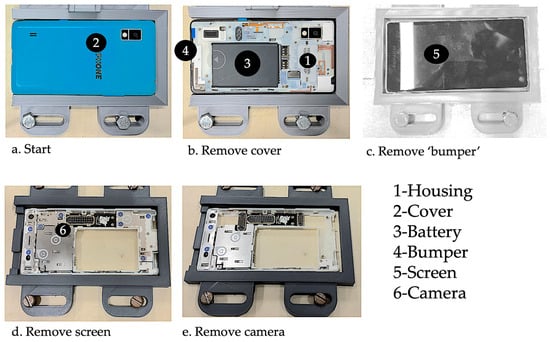
Figure 3.
Phone disassembly [13].
The relationship between the components is shown in a hypergraph (see Figure 4).
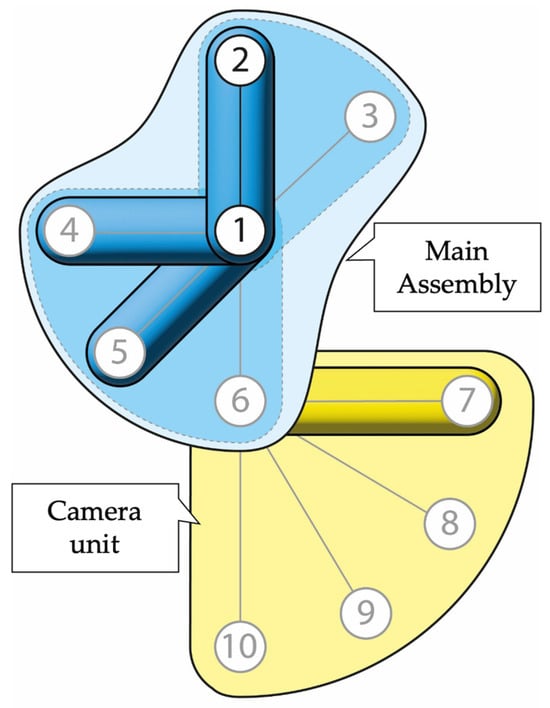
Figure 4.
Hypergraph phone.
At ‘disassembly depth’ level 0 (nothing disassembled yet), we find node 2 (−z orientation) for the back cover and one edge (1–2) at the −y orientation (assuming orthogonal axes), which is the snapfit that connects housing (node 1) and the back cover. At the next level, we find the battery (3) (−z) and the friction fit connection with the inner housing (1–3), or, from the (+z) perspective, node 5 (the bumper) and edge 1–5. Node 6 (the camera unit) is at the subsequent level (+z) and then the backplate (7), because this is a sub-assembly with nodes 8, 9, and 10. This is also shown in Table 4. So, if the ‘disassembly target’ is component 9 (the camera), this would require a hyperpath, as indicated by means of the red indicators in Figure 5. It extends from breaking edges 1–2 to 9 by breaking edges 1–2, 1–4, 1–5, 1–6, 6–7, and 6–9. A further illustration is provided in Figure 6 that depicts the step-by-step removal actions in the hypergraph format.

Table 4.
Hyperedge table for phone.
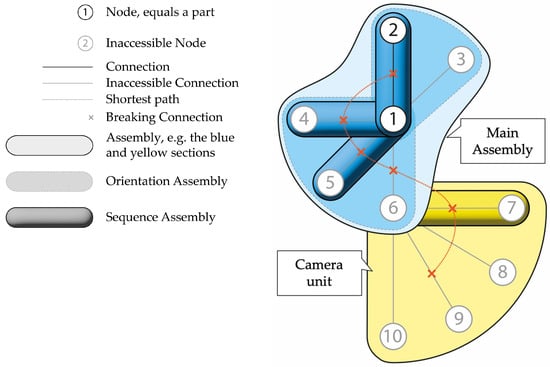
Figure 5.
Hypergraph phone with hyperpath.
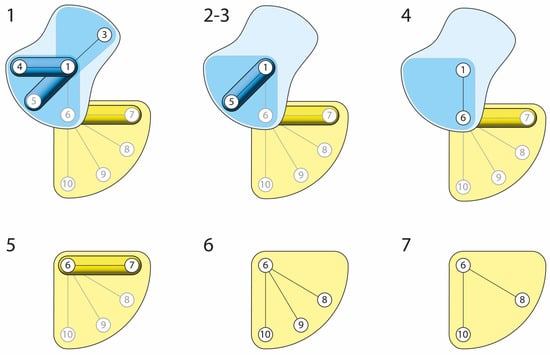
Figure 6.
Illustration disassembly sequence.
Reflecting upon the consistency and possible ambiguity of the resulting model, several remarks can be made: First, in order to avoid misunderstanding regarding the connection categories, it is proposed to extend the typification with separate categories for connectors truly separated from the product (like bolt-nut) and fasteners that combine elements of types 1 and 2. Also, connectors from adhesive materials are added, as shown in Table 5. This is suggested because when testing with a panel of four modeling teams, debates arose about the interpretation of Table 1.

Table 5.
Extended connection category typification.
Also, the accessibility topology in Figure 2 led to discussion between the modelers. A recommendation from this would be to provide additional examples of typical accessibility for frequently occurring connectors.
For this particular example product, it can be seen that 7 hyperedges are used to ‘simplify’ 10 nodes and 9 edges. The benefit of the hypergraph approach is avoiding infeasible disassembly paths because of the hyperedge specific accessibility and ‘free path’ information that otherwise cannot be made available because it is only valid in a particular orientation.
3.2. Generation of Disassembly Plans by Means of Hypergraphs
3.2.1. Requirements for Disassembly Plans from the Field
In order to collect input on requirements, seven Dutch SMEs active in ReX were visited to view their current way of working. Table 6 shows some characteristics of these companies. ReX companies often use specialized equipment like testing and diagnostic equipment for incoming return products, cleaning equipment, or high-accuracy machining. Most companies currently have a low automation degree, with the mentioned high-tech machining equipment being the exception. The majority of them aspire to automate or digitize their ReX processes in the near future, for instance by implementing cobots. The capabilities of the companies concern either large, specialized ReX know-how or the know-how required to apply stringent task-decomposition to allow people with limited ‘normal’ job prospects to execute ReX work [39]. All companies express concerns about the differences in digital skills between personnel and personnel shortages, particularly for experienced personnel with technical skills. The business models and typical markets for ReX companies differ, as shown in Table 6.

Table 6.
Companies visited for requirement collection.
Another observation to be made is that none of these companies are active in recycling. For Refurbishment, Remanufacturing, and Repair, scenarios for partial disassembly are more likely to occur (especially as when an organization is building up knowledge on a product type or series, it usually knows what components to target). These companies are not interested in optimal disassembly pathfinding per se but in the low-effort creation of disassembly manuals or programming.
Different user types can be identified (see Table 7) that have interest in the proposed generation of disassembly plans. In their current practice, disassembly experts typically create (paper) work order bills that describe the routing of subsequent process steps, with a reference to products, components, the materials processed, and the required tools and workstations. While, in ‘normal’ assembly, Bills-of-Materials (BOMs) for products are available to systematically generate such work orders, in ReX, this information is often lacking and has to be observed from the physical product itself. If most work is executed by the experts themselves, the required level of detail in these plans is typically low. As these experts become scarcer (declining inflow technical personnel, greying population), disassembly plans should be quicker to make, be easy to format for target users, and provide insights to decide upon the technical (and economic) viability of the required disassembly process. To guarantee a good trade-off between the effort and benefit of creating disassembly plans, reuse is another requirement. This refers to the easy (re)configuration of disassembly plans from one product into, for instance, another product family member. If the plans are intended for manual operators and task decoupling is required, the format of the disassembly plan should allow for clear, step-by-step instructions, enriched with tips and tricks for successful disassembly, provided by the expert. The required level of detail depends on the skill and preferences of the operators. Robot or cobot operators require additional task decoupling in disassembly plans that should be translated into machine-readable code, such as accounting for tool exchange, the manipulation of the product and components, etc. If the disassembly plan allows for the evaluation of which steps are applicable to automation, this provides further added value. For all users, the plan must provide a logical disassembly sequence that allows for safe, effective, and efficient work.

Table 7.
User requirements.
The interviewed companies saw benefits from product disassembly information through a Digital Product Passport and confirmed that because of the differences in ‘execution capabilities’, either from the aforementioned differences between personnel or from other situational context like access to certain tools, automation, or other facilities, disassembly plans cannot only be based on product properties. They confirm that the proposed disassembly hypergraph should have ‘dual use’, both for disassembly by humans and robots (and then, in some cases, be used to select the best disassembly resources).
3.2.2. Testing Creation of Disassembly Plans
To investigate the applicability of disassembly hypergraphs for planning, an attempt was made to create the disassembly plan for automatic phone disassembly (described in Coenen [13]) (based on the formulated disassembly hypergraph of Section 3.1.). For this, a disassembly workshop with a cobot was available. The workshop had the capability to fix the position of the phone on the workstation in a tray and provided multiple cobot–end-of-arm tools: a cup suction tool, a putty knife, and an electrical screwdriver. Table 8 shows what tools are preferably used for connector types (the rationale behind this selection was explained in [13]).

Table 8.
Cobot tools for the disassembly of a phone.
In order to systematically list the required disassembly actions, the systematics of eDIM operations are used, as shown in Table 9. One operation has to be added: ‘Fix’. This stems from the fact that in automatic disassembly, the use of fixtures is more important than it is for manual disassembly. Fix, Manipulate and Removal actions are applied to sub-assemblies, components, and type 3 (T03) connectors. Disconnect actions are relevant for type 1 and type 2 connectors. We identify actions that are relevant for all components (incl. sub-assemblies) and connectors. Tool change and position actions relate to tool actions. By systematically applying this to the hypergraph of the previous section, Table 9 is created, which specifies the required sequence of actions per component and connection.

Table 9.
Product disassembly plan.
It starts with positioning of the product (indicated by actions 00.1, 00.2, and 00.3). Then, the Cover action occurs, for which connections 1–2 with the inner housing has to be removed. This requires the following actions: 10.1 Tool Change to Putty Knife, 10.2 Tool Positioning, and 10.3 Disconnect Cover from Housing. Then, the Remove Cover action is divided into the following: 11.1 Change to Suction Cup Tool, 11.2 Position Suction Cup Tool, and 11.3 Remove Cover. The generated subsequent disassembly actions in the table specify, to a large extent, the tasks to be covered in cobot code, with the exception of the coordinates for tool positioning. In the demonstrated automatic phone disassembly process, this was addressed by creating ‘slots’ and ‘fixtures’ at fixed positions in the workstations, for which the locations were known by the cobot. Alternatively, fasteners could be located relatively simply by use of a camera (as it is clearly specified in the edge properties what the system has to look for). See, for instance, works on automated fastener identification and localization by scholars like [40,41].
So, with these minor adjustments to an eDIM table, the resulting Table 9 provides a more precise specification of actions and tool selection based on node and (hyper)edge properties. Some rationale in the form of knowledge rules is applied here: that in the selected workstation, the identification of components and connectors is not needed as the cobot has been loaded with geometry information in action 00.1; that preceding the application of a different tool, a tool change is required. The sequence of disassembly steps is similar to the hyperpath given in Figure 6. Tool changes and the manipulation of the product or components are time-consuming in automated processes. Manipulation is effectively reduced by first completing all disassembly actions from hyperedges with similar orientations (this does not occur in this example but assuming you want to remove both battery and the camera, it is beneficial to remove the battery while still in -z orientation.) Other considerations could come into play (for instance, safety criteria that say the battery should be removed as soon as possible).
The evaluation of the example in this section leads to the following reflections:
By combining the hypergraph model with ‘disassembly shop specifics’ as tools and capabilities, a feasible disassembly sequence can be generated and enhanced by applying criteria that reduce process time, such as preventing tool changeovers.
Node definition: By systematically considering tool requirements, additional relevant node properties have been identified like shape, center of gravity of components (needed to select a gripper), vulnerability (i.e., for static electricity), and state (damaged, dirty, etc.). The first two should be defined in a hyperedge-specific context, while the other two are general.
Taxonomies: Providing additional classification of fastening types with relevant properties is needed for tool selection and estimating (overall) disassembly time. The article of Das and Naik [34] contains a standard nomenclature for describing tools and fasteners. For the latter, a ‘relative unfastening rate’ is included that shows the differences in unfastening effort. In addition to the list provided by Das [34], ETIM classes (or similar) could be applied, for instance, [42], which refers to a standard classification of fastener features per type, but the required/allowed force and an indication of the unfastening rate should be added to such class definitions. De Fazio [16] and Turkbay Romano [43] suggest further additions such as snapfits or solder joints to public classification schemes; again, specifics like allowed or required force or temperature are required.
The extension of tool taxonomy required to be able to deal with a broader range of disassembly methods, including automated disassembly, can be partly based on [34,44], which specify ‘assembly tools for screws and nuts’. Additional tools are, for instance, listed in [32]. As observed by Erdmann and Turkbay Romano [31,43], these tools are mainly aimed at mechanical disassembly and, for instance, (de)soldering tools should be added, together with required (specification) parameters for such tools (like temperature range, tooltip width, etc.). Not only the tools for disconnection should be considered but also the tools for handling and manipulation. When working with tools, the available and required skill levels for executing particular actions should be specified as well to make sure that the disassembly plan specifies a correct tool and operator combination.
Manual vs. Automated: The distinction between manual and automated disassembly becomes particularly relevant in orientation considerations. Human operators can readily adjust product orientation to optimize access and ergonomics, whereas robotic systems face significant constraints in reorientation operations. These automated systems must deal with, for instance, gripper accessibility limitations, sensor visibility requirements, and/or predetermined motion pathways, making orientation changes both time-consuming and technically challenging. Precise component positioning and exact fastener locations must be known, and provisions must be made to handle, for instance, slightly altered product orientation or damage-induced variations. The aspect of tool pose and position has not been considered sufficiently. Further investigation is needed into prioritizing tools (if more than one selection is possible) and how to update the taxonomy of tools if a new way to use a tool is found.
The disassembly hypergraph format with node and (hyper)edge properties provides enough information to calculate disassemblability by the formulas of Ali [45] and allows (by using eDIM tables) for the estimation of disassembly time once MOST equivalents for automatic disassembly become available. A disassembly hypergraph can also be visualized in Disassembly Map format [16]. (An example is provided in Appendix A). Input that is related to the product or fastener state (damaged, dirty) at End-of-Life is lacking, however.
A last observation is that the presented phone disassembly is not fully representative of the use cases of the targeted SME companies, as this product has, by design, a very high disassemblability (designed for easy repair). The practical feasibility of the proposed methods will also depend on the calculation time required for assembly plans based on hypergraphs. As the models have not yet been tested for products with a large number of sub-assemblies and components, the performance is not clear yet. Iwase [20] observes a clear tipping point in calculation time when the number of edges exceeds a threshold value. He suggests that this usually results from sub-assemblies that have many connections with other sub-assemblies on higher disassembly depths and suggests merging the ‘children’ hyperedges. So, for the future, it might be needed to implement topological simplification, as, for instance, proposed by Schlag [46] or Zhou [47].
3.3. Working Towards Disassembly Class Diagram and Ontology
As demonstrated in the example for the phone, the disassembly hypergraph is a promising concept, but to turn the format into a disassembly plan or even a (fit-to-resource) disassembly instruction, an organization has to invest in setting up a disassembly ontology, including knowledge and rule bases as well, in order to enable fit-for-purpose disassembly plan generation.
This is illustrated in the Class Relationship for Disassembly Ontology (CRDO). It builds upon the model by Hu et al. [19] but is extended with the additional concept of orientation and disassembly depth. In order to support the structured selection of disassembly methods and actions for both manual and (semi-)automated methods, the concept of disassembly capabilities and workshop should also be added. See Figure 7 for the result.
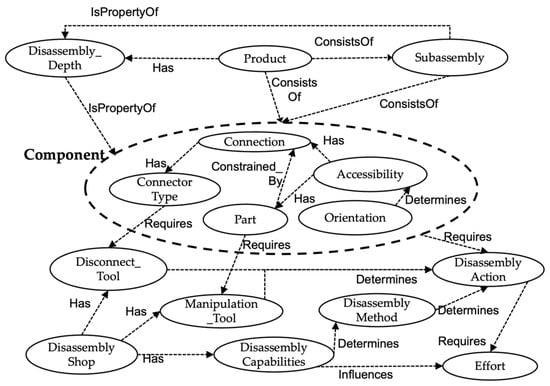
Figure 7.
Class Relationship for Disassembly Ontology (based on [19]).
The other implemented changes concern terminology (the ‘Direction’ class is changed to ‘Accessibility’ and the ‘Fastener’ class to ‘Connection’) to align with the earlier presented classes of Das and Naik [34]. Also, ‘Effort’ replaces ‘Cost’. Further inspired by the ontology-based method created by Hun [19], a ‘learning-based’ approach is proposed. That is, making use of ontologies to capture not only general disassembly knowledge but also organization- or capability-specific rules. This can open up the way to generate context-specific disassembly guides and subsequently generate personalized instructions. Hu [19] demonstrates this in a case study on smart remanufacturing by querying on a knowledge base and deriving new disassembly knowledge rules based on existing relations. This is carried out in order to create disassembly plans for products at End-of-Life.
Figure 8 illustrates how product hypergraphs, together with an evolving rule base that takes realized and observed disassembly processes as inputs, could be applied to fulfill disassembly practitioners’ needs. To be able to formulate sequence and sub-assembly rules, the disassembly step rationale and, in a later stage, also user experience and coding rule, disassembly processes should be observed and recorded.
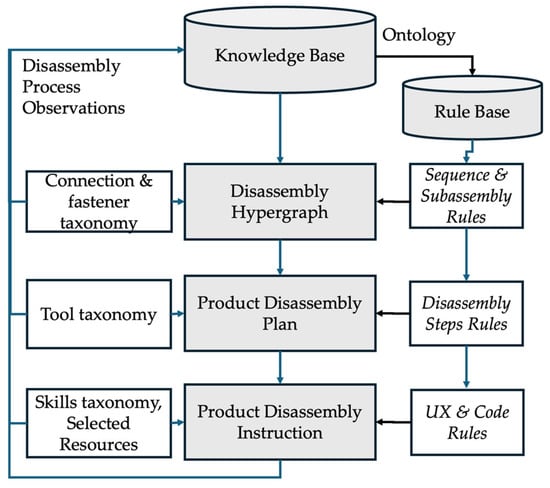
Figure 8.
Disassembly blueprint and outlook.
3.4. Data Collection Workshop for Disassembly Plans
In order to build up a repository of disassembly hypergraphs, several approaches are considered to collect the data of disassembly processes for future use.
The first option is by means of disassembly workshops, where participants disassemble and document connection types, tools used, and specifics like forces applied. The question for this article is how to organize the data collection process such that it can be automatically mapped onto the disassembly hypergraph. The workshops have a combined objective of raising awareness on repairability and ‘closing the loop’ (by reusing products, components, and materials), relieving people from ‘fixophobia’ (Coined by iFixit www.ifixit.com/News/6211/whats-your-fixophobia, accessed on 16 February 2025), collecting disassembly process data, and, particularly in this phase of research, streamlining the data collection methods required for a disassembly ontology.
The so-called ‘Dirty Hands-on’ workshop has been executed 18 times since the start of this project, usually with between 12 and 30 participants. The participants are currently recruited from different backgrounds, including students (from different educational levels) and professionals, both technical and non-technical.
Participants are working either in teams or individually on the disassembly of electrical (mainly household) devices, either provided by the researchers or brought along by the participants themselves. Although the use of ‘random’ and different devices is less attractive from a methodic point of view, pragmatic considerations prevail here (regarding the logistics of providing this large an amount of product samples to all the participants). In some workshops, video footage has also been created. Relevant technical insights, resulting from the workshops, show, for instance, that the inner or outer housing of the product presents specific challenges for disassembly operations, particularly the combination of visible screw connections and concealed snapfits. This is of course known already in the Design-for-Disassembly discourse, but it is particularly challenging for automatic disassembly, resulting in ‘costly’ limitations for tool accessibility, requiring extra manipulation steps or manual interference in processes. Additional complexities arise from material aging effects, particularly in polymer-based housings where normal product usage, but certainly repeated disassembly cycles, may compromise the integrity of connectors and structural elements (like ribs). The integration of sealing elements further impacts disassembly efficiency.
During the debriefing of the workshops, feedback on the usability of the form was collected, which led to some design iterations from a paper-based to an Excel-based form and finally the web-based form. Initially, disassembly processes were documented using handwritten forms inspired by the model proposed by Sundin [33]. These forms provided a basic framework for capturing steps like cleaning, inspection, disassembly, and reassembly. However, data quality was often compromised by poor handwriting, inconsistencies in detail, and the lack of standardization, limiting their utility for systematic analysis. To address the limitations of paper forms, an Excel-based version was introduced, incorporating dropdown menus with reference to the different taxonomies to ensure standardized input. For the taxonomies used for manual disassembly, see Appendix B. This approach was grounded in the previously described Disassembly Map [16]. While this version significantly improved data cleanliness and structure, debates arose regarding the classification of components, particularly distinguishing between parts and fasteners. Because not every user was equally technically adept, the webform was designed in such a way that it ensured valid data but provided an entry-level experience for those who needed it. Building on both prior iterations, the web-based form added visual aids and direct integration with hypergraph structures. For example, the user presses a button according to the type of connection (bolted, press-fitted, glued), after which the form automatically sorted this into a relevant category (Table 3: Connection type). The user indirectly records the ‘disassembly depth’ he is working on by indicating if there are alternative parts to work on. Also, part reorientation and the direction of a disassembly action is indicated. This produces cleaner data. The form functions on both mobile devices and laptops.
The technical specs of the tools cover the storage of recorded data in .json format through an API connection that is stable and robust enough to sustain a stress level of ~20 users intensively entering data for a period of time (~2 h) combined with the upload of photos and video. In-line data cleansing or data validation upon entry is not implemented yet as the drop-down lists of connection and tool types mainly covers this issue. A user is allowed to specify an ‘other’ type (both connector and tool), however, in order to collect inputs for improving the connection and tool taxonomies. Reasoning towards the disassembly graph is carried out ‘below the hood’ by first generating a normal graph for the identified components and connection node, then defining temporary hyperedges that contain the parts that are addressed from a certain orientation, and then reasoning the disassembly depth level from the indicated alternative operations (if alternatives are mentioned by the participants, this implies that they have the same disassembly depth). Figure 9 shows some screenshots from the form for mobile devices. In Table 10, the filled-in form for the phone example is shown. When a participant saves the form, the table is converted into the disassembly hypergraph format and subsequently saved. Based on the aforementioned observations, some questions remain on the usefulness of the recorded properties for correct tool and action selection for automated processes.
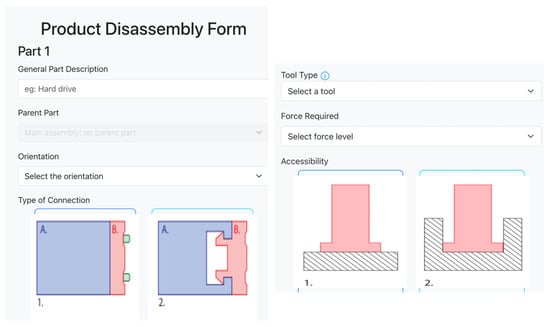
Figure 9.
A screenshot from the webform, with in pink the part to be removed.

Table 10.
Filled-in form data collection workshop for a phone (manual tools).
As incremental changes have been made to the setup of the workshop and the data collection form, and because the sampling of products and participants is pretty random, no final conclusions concerning the quality of data collection can be drawn yet. The recorded data in the initial workshops were not always sufficient and the results thus far show inconsistencies because of changes in the workshop documentation form and instructions. Nevertheless, the results did provide valuable insights to improve the data collection process. By using a user-friendly, electronic data collection form, the concepts for disassembly classification could not necessarily be fully understood by participants, but this still led to valid data that could be mapped onto the disassembly hypergraph format. The collected data in this format could indeed be processed and stored, but the best format (for instance, relational database or graph database) allowing the information to be retrieved as a meaningful input for (self-learning) disassembly plans remains to be researched. Once this is achieved, the workshop format allows for ‘offline disassembly teach’ and repository building as a source for generating disassembly plans, code, and instruction configuration.
In terms of taking away fixophobia, the workshop seems very effective though: participants found it surprisingly fun to take a product apart and discover how the product is put together. This was a reason to already start collecting photographs and videos of the process (this was often carried out on users’ initiative). The workshop program will continue in the coming year, allowing for the improvement of the data consistency and further evaluation of the resulting hypergraph consistencies, including more parallel experiments with different participants working on identical products.
An alternative option is to apply Human Action Recognition (HAR), as explained by Zhang [48], which analyzes video data using machine learning to identify disassembly steps, tool use, and effort estimation. This observation method and subsequent mapping onto the disassembly hypergraph was briefly explored and showed good potential. It is out of scope for this article, however.
4. Discussion
4.1. Conclusions and Findings
In order to facilitate the future automated generation of a disassembly plan and instructions for ReX, the following contributions were realized:
- The application of hypergraphs as a format to capture relevant disassembly information for a real-life case and to identify a feasible path to a failed component.
- An example was presented on how to map disassembly expertise onto the disassembly hypergraph by using a modified eDIM table (primarily extended with automated disassembly in mind). It was shown that this can be applied to generate disassembly plans in an efficient manner based on limited information about the product. Considerations such as minimizing tool changes in the disassembly sequence can easily be implemented.
- Suggestions for tool and connector taxonomies were made and their use demonstrated for the case of the disassembly of a phone (both manual and automated); once richer taxonomies become available that also contain end-of-arm tools for robots and cobots, (mis)matches between connection types and available capabilities can be analyzed based on the hypergraph format.
- Insights on how to collect inputs for future ontologies from ‘citizen science’-style experiments by means of a carefully defined form. The data collection workshops led to the conclusion that the observation of physical disassembly activities can provide relevant inputs for adequate disassembly plans by recording disassembly actions and automatically storing them in a disassembly hypergraph. This format contains similar information as, for instance, De Fazio’s format, but serves a different purpose, i.e., to be interpreted, compared, and analyzed by machines.
- Based on these results, it is reasonable to expect that SME remanufacturing companies can benefit from the disassembly hypergraph concept. By recording a product disassembly (like that in the proposed workshop, but by an experienced operator), a hypergraph can be generated that, in turn, can be (semi-)automatically turned into a disassembly plan that, in turn, can be used to generate an overview of required tasks and tools. The graphs provide information for assessing disassemblability (which is relevant for estimating the economic viability of the circular manufacturing of a series of (similar) products).
4.2. Recommendations and Outlook
As shown in this paper, further work is needed to realize standardized and accessible connector and tool taxonomies. Disassembly ‘recording’ experiments should be replicated, first for the phone (with the described modifications of the hypergraph method incorporated), but more importantly, for other more complicated products, with more complex product breakdown structures (more parts, more levels). The workshop should be continued but the data collection methods must be stabilized to improve the consistency of the data. The workshop should also be tested with disassembly experts to collect additional insights. As mentioned, tests should be executed to select adequate database formats for the storage of disassembly hypergraphs. As briefly mentioned in Section 3.4, data collection for disassembly ontology can be expanded to the analysis of video footage by means of HAR and map this to the disassembly graph format. Both HAR and the disassembly workshops allow for data collection on disassembly knowledge rules. Another interesting direction is to collect product topologies and component/connector features from reverse-engineered geometry models, obtained by 3D scanning or applying vision-based techniques like YOLO, etc.
Further research should also explore enhancing disassembly hypergraphs towards the generation of fit-for-purpose disassembly guides, code, and instructions and include the evaluation of the quality of the generated material. Additionally, ReX companies should also implement knowledge bases with a disassembly ontology that contains both generic knowledge and best-practices for disassembly but is enriched with rules concerning their capabilities and tooling. This can result in a ‘learning model’ that is fueled with real-life, realized disassembly actions. Also, future AI integration could enable autonomous adaptation to product variations (in combination with cameras in the disassembly setup). Large Language Models are expected to play a role in the generation of detailed disassembly guides. This effort should be combined with exploring possibilities for similarity mapping and the reconfigurability of disassembly graphs and plans. Also, alternative or parallel disassembly sequences and how to select between them, for instance, based on estimated disassembly times, could be elaborated. The method could also be elaborated in the direction of a disassembly method evaluation tool (and we could see the differences between different tools and capabilities, which could be useful for investment decisions, particularly when combined with the disassemblability assessment)
Finally, a typical real-life aspect that impacts disassembly efficiency is the required cleaning of products, components, and connectors. This is still ignored in both the existing literature and this paper but needs further research efforts.
Supplementary Materials
The following supporting information can be downloaded at https://www.mdpi.com/article/10.3390/automation6010010/s1: workshop manual, data collection form, and source code.
Author Contributions
Conceptualization J.C. and A.V.; methodology, M.Z., A.V. and J.C.; software, N.d.B.; validation, J.C., A.V. and M.Z.; writing—original draft preparation, J.C.; writing—review and editing, A.V.; visualization, N.d.B. and J.C. All authors have read and agreed to the published version of the manuscript.
Funding
This research received no external funding.
Data Availability Statement
Data are largely contained within the article or Supplementary Materials; the remainder of the dataset available on request from the authors.
Acknowledgments
Many students at The Hague University of Applied Sciences contributed to the data collection workshops.
Conflicts of Interest
The authors declare no conflicts of interest.
Appendix A
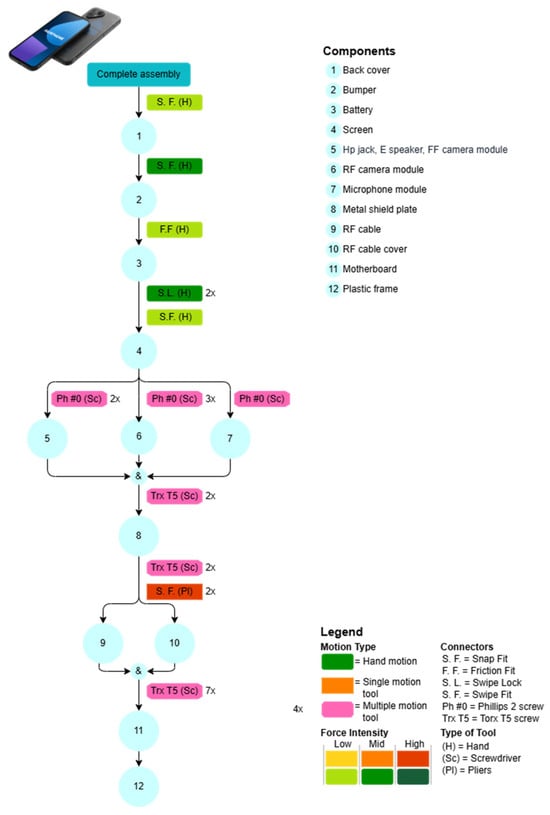
Figure A1.
Disassembly Map (following the method of De Fazio [16]) for a phone.
Appendix B

Table A1.
Tool taxonomy used for data collection workshop (manual tools).
Table A1.
Tool taxonomy used for data collection workshop (manual tools).
| Tool, Action (Short) | Long Description |
|---|---|
| 1. Manual, remove part | Manually removing part without breaking a connection. |
| 2. Screwdriver, ±9 turns | Screwdriver (Slotted, Phillips, Pozi, or Torx) for screw/bolt removal with 9 turns. |
| 3. Manual, friction-fit < 5 N | Manually removing friction-fit with less than 5 N force. |
| 4. Manual, friction-fit 5–20 N | Manually removing friction-fit with force between 5 N and 20 N. |
| 5. Manual, friction-fit > 20 N | Manually removing friction-fit with more than 20 N force. |
| 6. Manual, snapfit < 5 N | Manually snapfit disassembly with less than 5 N force. |
| 7. Manual, snapfit 5–20 N | Manually snapfit disassembly with force between 5 N and 20 N. |
| 8. Manual, snapfit > 20 N | Manually snapfit disassembly with more than 20 N force. |
| 9. Spudger, friction-fit < 5 N | Spudger used for friction-fit disassembly with less than 5 N force. |
| 10. Spudger, friction-fit 5–20 N | Spudger used for friction-fit disassembly with force between 5 N and 20 N. |
| 11. Spudger, friction-fit > 20 N | Spudger used for friction-fit disassembly with more than 20 N force. |
| 12. Spudger, snapfit < 5 N | Spudger used for snapfit disassembly with less than 5 N force. |
| 13. Spudger, snapfit 5–20 N | Spudger used for snapfit disassembly with force between 5 N and 20 N. |
| 14. Spudger, snapfit > 20 N | Spudger used for snapfit disassembly with more than 20 N force. |
| 15. Allen wrench, ±9 turns | Allen wrench used for hexagon screw or bolt disassembly with nine turns. |
| 16. Pliers, pry open clamp | Special pliers to open a clamp in order to remove it. |
| 17. (Wire) cutter, scissors or knife, cut | Removing connection-like tie wrap by cutting. |
| 18. Forceps, removal (small) parts | Very small parts are delicate and require accurate grip and positioning. |
| 19. Socket wrench, ±9 turns | Force-locked connection that requires force > 20 N, connection approachable from both sides. |
| 20. (Putty) knife and/or solvent, connecting material, glue or sealant | Specific solvent and/or (putty) knife required for removing material and or prying it loose. |
| 21. Solder iron, connecting material, solder | Soldering iron needed to break/remove connection |
| 22. Other, other disassembly handlings | Other: Describe what tool (hammer, power tool, other) you used, with what force, what particular actions you executed, and what (auxiliary) tools would have been useful or required. |
References
- Ministry for the Environment. National Circular Economy Programme 2023–2030; Ministry for the Environment: Wellington, New Zealand, 2023. [Google Scholar]
- EU. Regulation (EU) 2024/1781 of the European Parliament and of the Council of 13 June 2024 Establishing a Framework for the Setting of Ecodesign Requirements for Sustainable Products, Amending Directive (EU) 2020/1828 and Regulation (EU) 2023/1542 and Repealing Directive 2009/125/EC. 2024. Available online: https://eur-lex.europa.eu/legal-content/EN/TXT/?uri=CELEX%3A32024R1781&qid=1719580391746 (accessed on 23 December 2024).
- EU. Directive (EU) 2022/2464 of the European Parliament and of the Council of 14 December 2022 amending Regulation (EU) No 537/2014, Directive 2004/109/EC, Directive 2006/43/EC and Directive 2013/34/EU, as Regards Corporate Sustainability Reporting. 2022. Available online: https://eur-lex.europa.eu/eli/dir/2022/2464/oj/eng (accessed on 19 February 2025).
- Jungbluth, J.; Gerke, W.; Plapper, P. An Intelligent Agent-Controlled and Robot-Based Disassembly Assistant. IOP Conf. Ser. Mater. Sci. Eng. 2017, 235, 012005. [Google Scholar] [CrossRef]
- Bradley, R.; Jawahir, I.S.; Badurdeen, F.; Rouch, K. A total life cycle cost model (TLCCM) for the circular economy and its application to post-recovery resource allocation. Resour. Conserv. Recycl. 2018, 135, 141–149. [Google Scholar] [CrossRef]
- Ding, Z.; Jiang, Z.; Liu, Y.; Wang, Y.; Li, C. A Big Data based Cost Prediction Method for Remanufacturing End-of-Life Products. Procedia CIRP 2018, 72, 1362–1367. [Google Scholar] [CrossRef]
- Alba Concepts. Normering Financiële Waardebepaling. Available online: https://circulairemaakindustrie.nl/documenten/normering-financiele-waardebepaling/ (accessed on 10 June 2023).
- Weber, H. Remanufacturing: A New Imperative in Times of Circularity and E-Mobility. Munchen, May 2023. Available online: https://www.berylls.com/wp-content/uploads/2023/05/BSA-Study-Remanufacturing-05-2023.pdf (accessed on 16 February 2025).
- Hjorth, S.; Chrysostomou, D. Human–robot collaboration in industrial environments: A literature review on non-destructive disassembly. Robot. Comput. Integr. Manuf. 2022, 73, 102208. [Google Scholar] [CrossRef]
- Balkenende, R.; Bakker, C.; Blondel, E.; Henneberry, Y. Repair in the Circular Economy; TU Delft OPEN Publishing: Delft, The Netherlands, 2024. [Google Scholar] [CrossRef]
- Poschmann, H.; Bruggemann, H.; Goldmann, D. Robot Cognition in Disassembly Advanced Information Processing for an Adaptive Dismantling Ecosystem. In Adaptive 2020, the Twelfth International Conference on Adaptive and Self-Adaptive Systems and Applications; IARIA: Wilmington, DE, USA, 2020. [Google Scholar]
- Sierra-Fontalvo, L.; Polo-Cardozo, J.; Maury-Ramírez, H.; Mesa, J.A. Diagnosing remanufacture potential at product-component level: A disassemblability and integrity approach. Resour. Conserv. Recycl. 2024, 205, 107529. [Google Scholar] [CrossRef]
- Coenen, J.; Makkink, H.; Zijderveld, M. Disassembly Strategies for Remanufacturing: Experiences from a Learning Factory. In International Workshop on Autonomous Remanufacturing; Springer Nature: Cham, Switzerland, 2024; pp. 501–512. [Google Scholar] [CrossRef]
- CIRPASS Consortium. Summary of ‘Proposal for a Regulation of the European Parliament and of the Council Concerning Batteries and Waste Batteries, Repealing Directive 2006/66/EC and Amending Regulation (EU) No 2019/1020 (2020/0353(COD))’. May 2023. Available online: https://cirpassproject.eu/wp-content/uploads/2023/05/The-DPP-as-defined-in-the-Battery-Regulation-proposal.pdf (accessed on 25 September 2023).
- CIRPASS Consortium. The Digital Product Passport as Defined in the Proposal for Eco-Design for Sustainable Product Regulation (ESPR). March 2022. Available online: https://cirpassproject.eu/wp-content/uploads/2023/03/ESPR-short-summary-Final.pdf (accessed on 25 September 2023).
- De Fazio, F.; Bakker, C.; Flipsen, B.; Balkenende, R. The Disassembly Map: A new method to enhance design for product repairability. J. Clean. Prod. 2021, 320, 128552. [Google Scholar] [CrossRef]
- Peeters, J.R.; Tecchio, P.; Ardente, F.; Vanegas, P.; Coughlan, D.; Duflou, J.R. eDIM: Further Development of the Method to Assess the Ease of Disassembly and Reassembly of Products—Application to Notebook Computers. 2018. Available online: https://publications.jrc.ec.europa.eu/repository/bitstream/JRC107773/jrc107773_20180302_-_edim_2_clean_-_online.pdf (accessed on 19 February 2025).
- Vanegas, P.; Peeters, J.R.; Cattrysse, D.; Tecchio, P.; Ardente, F.; Mathieux, F.; Dewulf, W.; Duflou, J.R. Ease of disassembly of products to support circular economy strategies. Resour. Conserv. Recycl. 2018, 135, 323–334. [Google Scholar] [CrossRef]
- Hu, Y.; Liu, C.; Zhang, M.; Lu, Y.; Jia, Y.; Xu, Y. An ontology and rule-based method for human–robot collaborative disassembly planning in smart remanufacturing. Robot. Comput. Integr. Manuf. 2024, 89, 102766. [Google Scholar] [CrossRef]
- Iwase, S. AND/OR graph generation for disassembly analysis: Deeply-nested subassemblies represented by a hypergraph. Int. J. Prod. Res. 2024, 1–29. [Google Scholar] [CrossRef]
- Ong, S.K.; Chang, M.M.L.; Nee, A.Y.C. Product disassembly sequence planning: State-of-the-art, challenges, opportunities and future directions. Int. J. Prod. Res. 2021, 59, 3493–3508. [Google Scholar] [CrossRef]
- Zheng, Z.; Xu, W.; Zhou, Z.; Pham, D.T.; Qu, Y.; Zhou, J. Dynamic Modeling of Manufacturing Capability for Robotic Disassembly in Remanufacturing. Procedia Manuf. 2017, 10, 15–25. [Google Scholar] [CrossRef]
- Münker, S. Automated Assembly Sequence Planning of Large-Scale Assemblies. Ph.D. Thesis, RWTH Aachen University, Aachen, Germany, 2023. [Google Scholar]
- Xing, Y.; Chen, G.; Lai, X.; Jin, S.; Zhou, J. Assembly sequence planning of automobile body components based on liaison graph. Assem. Autom. 2007, 27, 157–164. [Google Scholar] [CrossRef]
- de Mello, L.S.H.; Sanderson, A.C. Representations of mechanical assembly sequences. IEEE Trans. Robot. Autom. 1991, 7, 211–227. [Google Scholar] [CrossRef]
- De Fazio, T.; Whitney, D. Simplified generation of all mechanical assembly sequences. IEEE J. Robot. Autom. 1987, 3, 640–658. [Google Scholar] [CrossRef]
- Bourjault, A. Methodology of Assembly Automation: A New Approach. In Robotics and Factories of the Future’87; Springer: Berlin/Heidelberg, Germany, 1988; pp. 37–45. [Google Scholar] [CrossRef]
- Münker, S.; Göppert, A.; Schmitt, R.H. Suitability of CAD-based Disassembly Sequence Plans for Flexible Remanufacturing. Procedia CIRP 2023, 120, 738–743. [Google Scholar] [CrossRef]
- Riesen, K. Graph Edit Distance. In Structural Pattern Recognition with Graph Edit Distance; Springer: Cham, Switzerland, 2015; pp. 29–44. [Google Scholar] [CrossRef]
- Boothroyd, G. Product design for manufacture and assembly. Comput. Aided Des. 1994, 26. [Google Scholar] [CrossRef]
- Erdmann, J.G.; Koller, J.; Brimaire, J.; Döpper, F. Assessment of the disassemblability of electric bicycle motors for remanufacturing. J. Remanuf. 2023, 13, 137–159. [Google Scholar] [CrossRef]
- NEN-EN 4554:2020; General Method for the Assessment of the Ability to Repair, Reuse and Upgrade Energy Related Products. NEN-Royal Dutch Standardisation Institute: Gent, Belgium, 2020.
- Sundin, E.; Bras, B. Making functional sales environmentally and economically beneficial through product remanufacturing. J. Clean. Prod. 2005, 13, 913–925. [Google Scholar] [CrossRef]
- Das, S.K.; Naik, S. Process planning for product disassembly. Int. J. Prod. Res. 2002, 40, 1335–1355. [Google Scholar] [CrossRef]
- Bozhko, A.N. Hypergraph model for assembly sequence problem. IOP Conf. Ser. Mater. Sci. Eng. 2019, 560, 012010. [Google Scholar] [CrossRef]
- Wang, H.; Xiang, D.; Rong, Y.; Zhang, L. Intelligent disassembly planning: A review on its fundamental methodology. Assem. Autom. 2013, 33, 78–85. [Google Scholar] [CrossRef]
- Trigui, M.; Belhadj, I.; Benamara, A. Disassembly plan approach based on subassembly concept. Int. J. Adv. Manuf. Technol. 2017, 90, 219–231. [Google Scholar] [CrossRef]
- Gao, J.; Zhao, Q.; Ren, W.; Swami, A.; Ramanathan, R.; Bar-Noy, A. Dynamic Shortest Path Algorithms for Hypergraphs. IEEE/ACM Trans. Netw. 2015, 23, 1805–1817. [Google Scholar] [CrossRef]
- Zijderveld, M.; Coenen, J.; vd Burgh, H. Next step towards flexible disassembly cells; continued lessons of a learning factory. In IWAR 2024; 2024; in preparation. [Google Scholar]
- Mangold, S.; Steiner, C.; Friedmann, M.; Fleischer, J. Vision-Based Screw Head Detection for Automated Disassembly for Remanufacturing. Procedia CIRP 2022, 105, 1–6. [Google Scholar] [CrossRef]
- Zhou, C.; Wu, Y.; Sterkens, W.; Piessens, M.; Vandewalle, P.; Peeters, J.R. Towards robotic disassembly: A comparison of coarse-to-fine and multimodal fusion screw detection methods. J. Manuf. Syst. 2024, 74, 633–646. [Google Scholar] [CrossRef]
- ETIM. ETIM Classes for Fixings and Fasteners. 2024. Available online: https://www.etim-uk.co.uk/wp-content/uploads/2024/01/ETIM-UK-Fixings-Fasteners-Guidance-Notes-v1.0-Jan-2024.pdf (accessed on 21 December 2024).
- Turkbay Romano, T.; Fang, L.; Alix, T.; Rio, M.; Mélot, J.; Serrano, F.; Lefranc, P.; Lembeye, Y.; Perry, N.; Crébier, J.C. Disassemblability Assessment of Power Electronic Converters for Improved Circularity. Sustainability 2024, 16, 4712. [Google Scholar] [CrossRef]
- NEN-ISO 1703:2018; Assembly Tools for Screws and Nuts—Nomenclature. NEN-ISO: Gent, Belgium, 2018. Available online: https://www.iso.org/standard/69308.html (accessed on 16 February 2025).
- Ali, A.; Enyoghasi, C.; Badurdeen, F. A Quantitative Approach for Product Disassemblability Assessment. In Role of Circular Economy in Resource Sustainability; Springer: Cham, Switzerland, 2022; pp. 73–84. [Google Scholar] [CrossRef]
- Schlag, S.; Heuer, T.; Gottesbüren, L.; Akhremtsev, Y.; Schulz, C.; Sanders, P. High-Quality Hypergraph Partitioning. ACM J. Exp. Algorithmics 2022, 27, 1–39. [Google Scholar] [CrossRef]
- Zhou, Y.; Rathore, A.; Purvine, E.; Wang, B. Topological Simplifications of Hypergraphs. IEEE Trans. Vis. Comput. Graph. 2023, 29, 3209–3225. [Google Scholar] [CrossRef]
- Zhang, H.-B.; Zhang, Y.-X.; Zhong, B.; Lei, Q.; Yang, L.; Du, J.-X.; Chen, D.-S. A Comprehensive Survey of Vision-Based Human Action Recognition Methods. Sensors 2019, 19, 1005. [Google Scholar] [CrossRef]
Disclaimer/Publisher’s Note: The statements, opinions and data contained in all publications are solely those of the individual author(s) and contributor(s) and not of MDPI and/or the editor(s). MDPI and/or the editor(s) disclaim responsibility for any injury to people or property resulting from any ideas, methods, instructions or products referred to in the content. |
© 2025 by the authors. Licensee MDPI, Basel, Switzerland. This article is an open access article distributed under the terms and conditions of the Creative Commons Attribution (CC BY) license (https://creativecommons.org/licenses/by/4.0/).